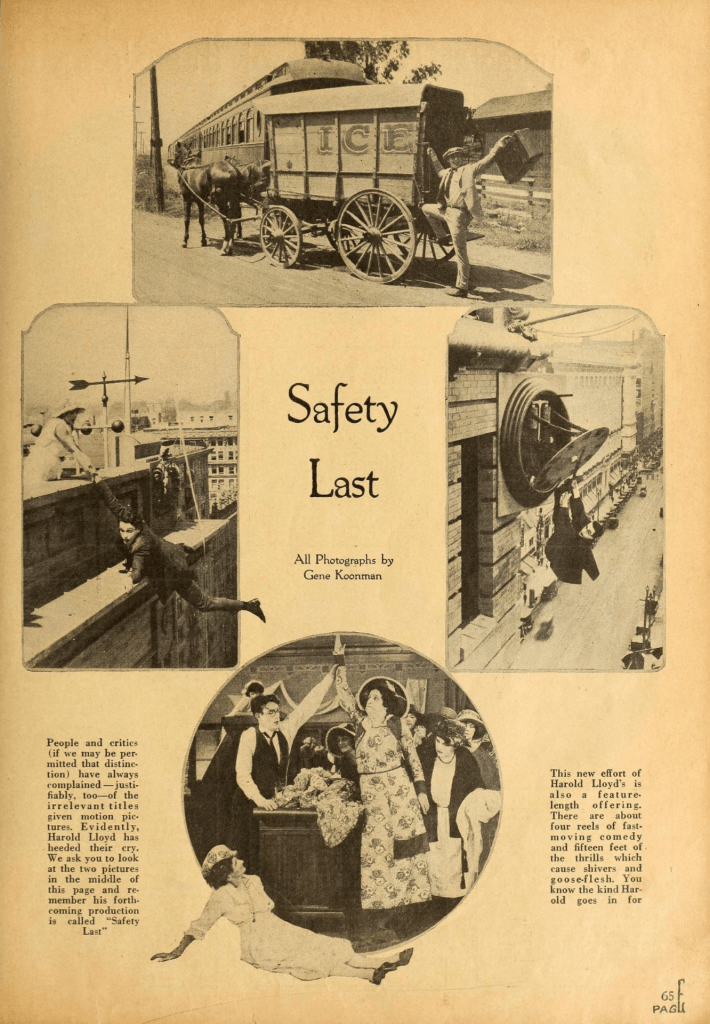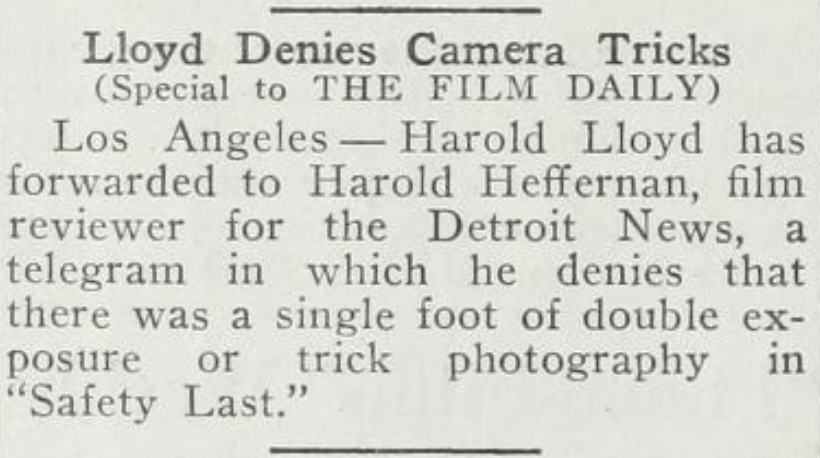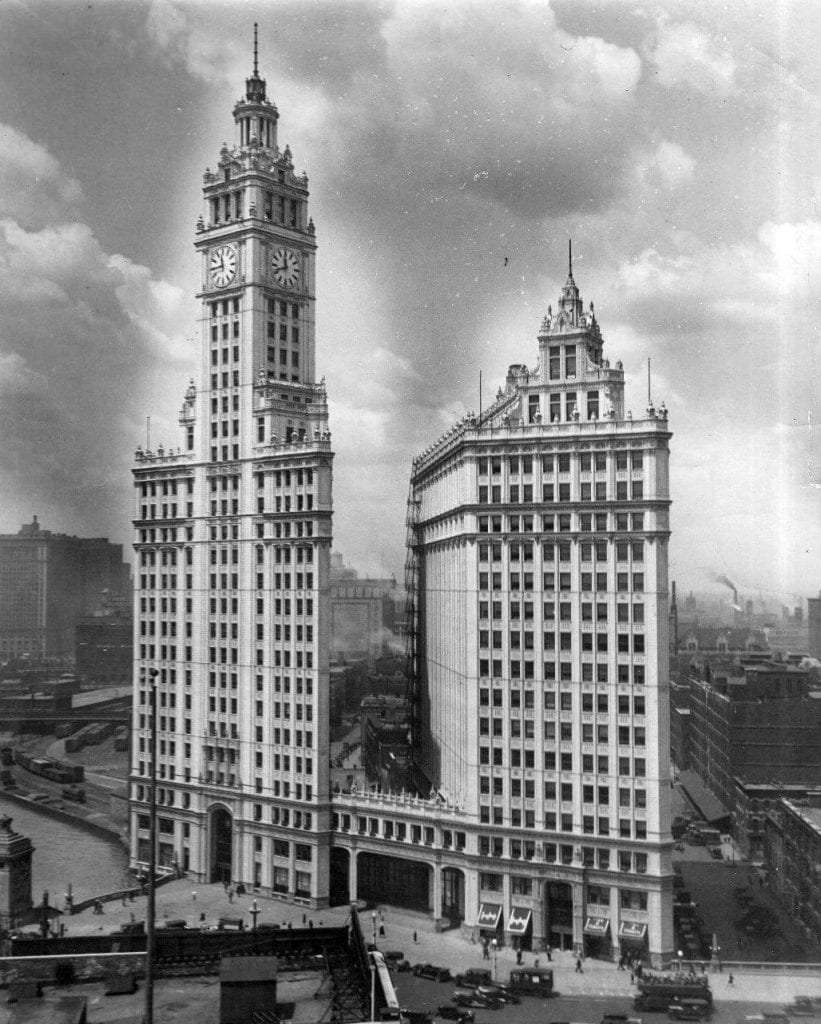
At twelve noon in Broadway, New York, Harry S. Young, billed the “human fly,” began climbing the side of the Martinique Hotel in 1923. Thousands of people gathered at Greely Square just below the hotel to watch the spectacle, including his wife. After climbing up ten stories Young slipped and fell to his death. The phrase “Safety Last” was painted on the back of his shirt. It was part of a publicity stunt for Harold Lloyd’s new film, Safety Last! (1923). Young was hired by Pathé, the film’s production company, and paid fifty dollars for the stunt.
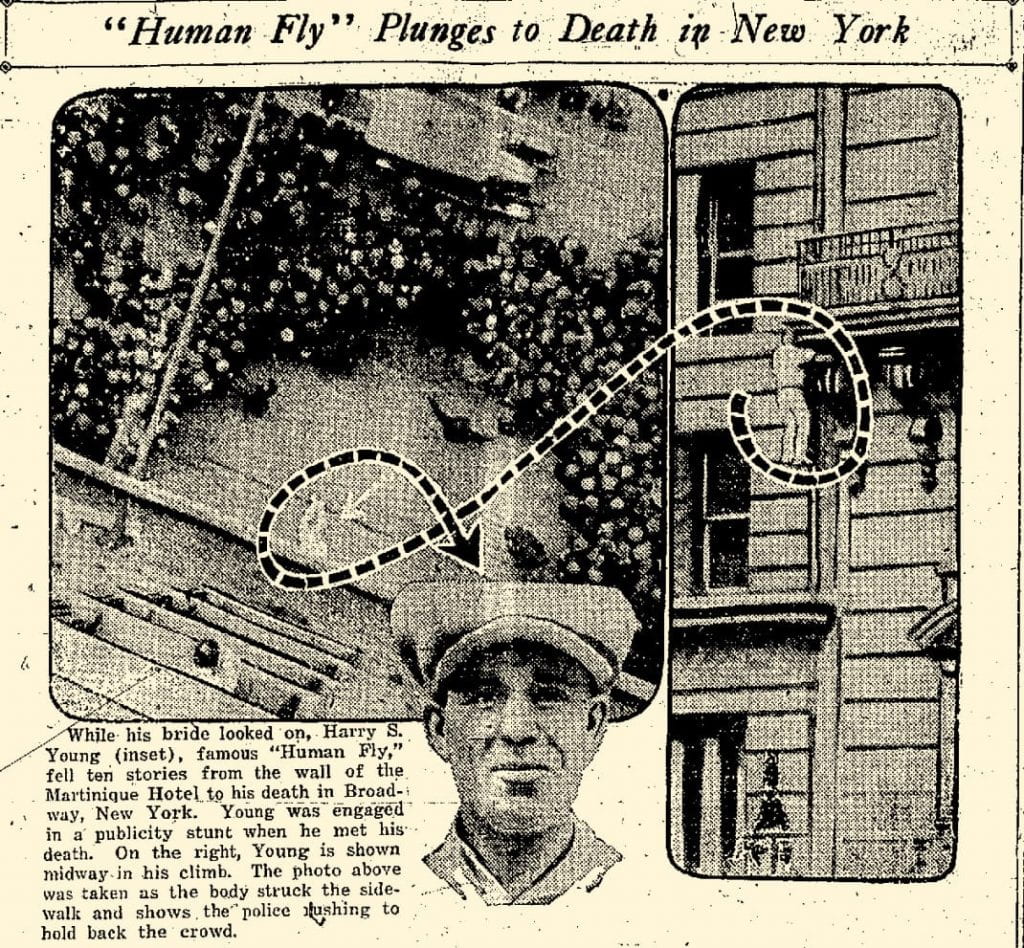
This publicity stunt, though tragic, only fueled the runaway success of Safety Last!, which follows a sales clerk (Lloyd) trying to get a promotion to impress his girlfriend (Mildred Davis) by concocting a publicity stunt where a human fly climbs his company’s building. Things inevitably go wrong and Lloyd ends up having to climb the building himself while overcoming increasingly nerve-wracking and hilarious obstacles on his way to the top. In fact, it was another such feat of daring by a real human fly that inspired Lloyd to create the film. In July of 1922 Lloyd saw a group of people staring up at the Brockman Building on 7th Street in Los Angeles. Intrigued, Lloyd couldn’t help but look on in fear and fascination after realizing what he was seeing. In an interview recalling the event he said,
I watched him scale this whole building, by just occasionally peeking at him, until he finally reached the top. He got up there, and he had a bicycle and he rode the bicycle around the edge of the building. Then he got on the flag-pole, and he stood on his head. Well, it made such a terrific impression on me, and stirred my emotions to such a degree that I thought, ‘My, if it can possibly do that too an audience — if I capture that on the screen — I think I’ve got something that’s never been done before.’
After the event Lloyd found the climber, Bill Strothers, and invited him to meet with Hal Roach, Lloyd’s producer, at his studio. Roach placed him under contract for Safety Last!, and appears in the film as “Limpy Bill.” The name was earned after Strothers became impatient waiting for the movie to start production and decided to take on a simple climb of just three stories that ironically ended up in a broken leg and limp, hence the name.
Apparently, the human fly gig wasn’t the safest line of work to be in — who would have guessed? — but it surely drew crowds, and Safety Last! certainly did that. The advertisement below highlights telegrams from theatres all over the country recounting the extraordinary turnout and record-breaking attendance of the film. The manager of the Majestic Theatre in Portland, Oregon proclaimed, “They are tearing the arms off of the chairs and laughing so loudly the organist can’t hear himself play… Expect the run to break the six week record established by Doctor Jack.” Dr. Jack was another successful Lloyd film released the previous year in 1922.
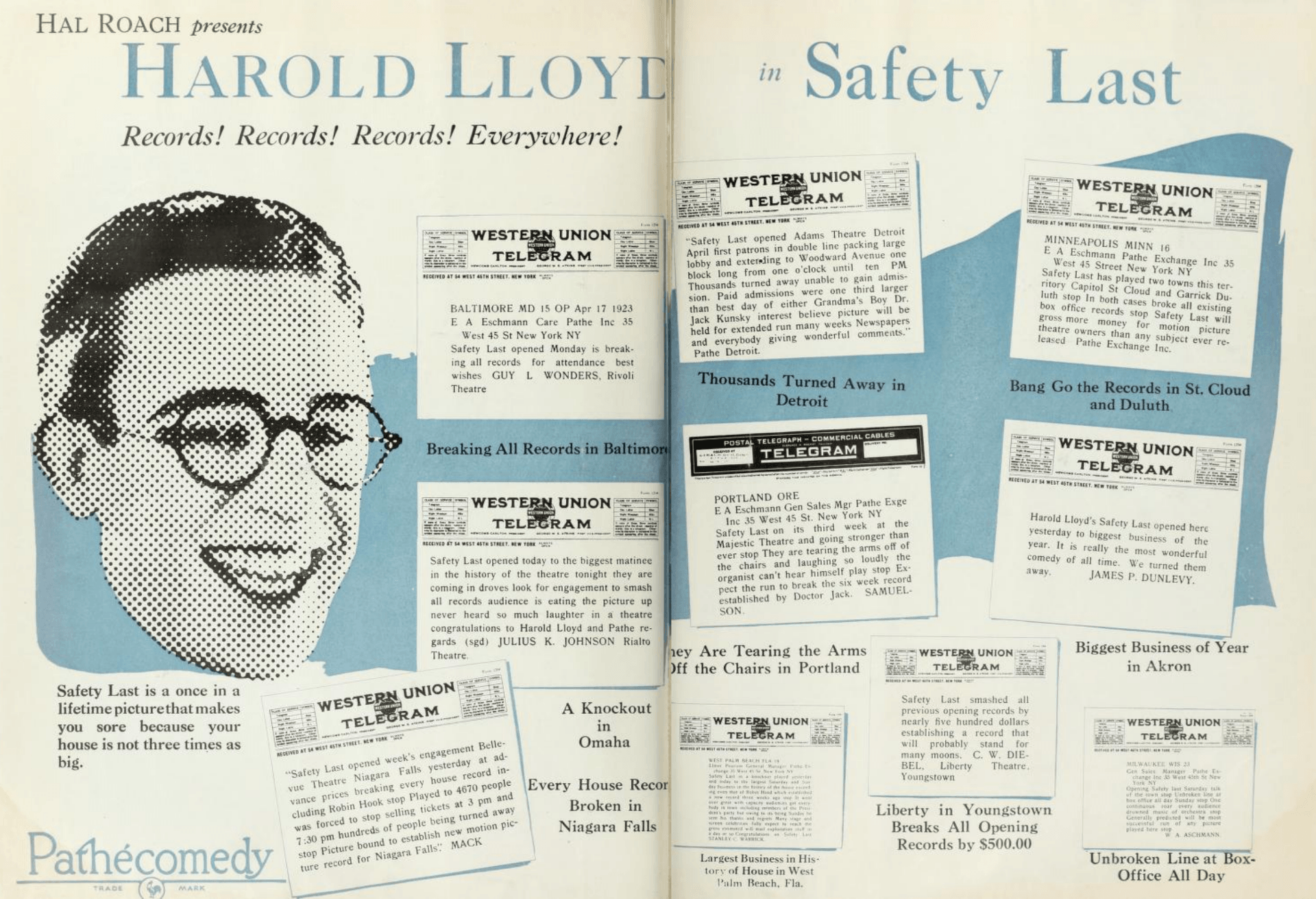
The success of the film can be largely attributed to Lloyd’s absolute need for perfection with his onscreen gags, which were so cleverly constructed and precisely executed that many took them to be absolutely genuine. But one fan magazine, Motion Picture Magazine, was just relieved that a film’s title finally matched its contents, commenting, “People and critics (if we may be permitted that distinction) have always complained — justifiably, too — of the irrelevant titles given motion pictures. Evidently, Harold Lloyd has heeded their cry. We ask you to look at the two pictures in the middle of this page and remember his forthcoming production is called ‘Safety Last.'”
Lloyd himself would be conspicuously ambiguous in interviews and promotional material at various times so that one was never quite sure if his stunts put him in real danger. In some accounts he was quite frank about the film’s set construction, revealing how they built miniature sets on the rooftops of four separate buildings of different heights to convey the proper perspectives as he climbed. In other accounts he wholly suppressed these details. One early newspaper account even has Lloyd telling a film critic in Detroit that no special “trick photography” was used to achieve the film’s effects.
These conflicting accounts led to a rather tricky situation for Lloyd when some city officials believed he could actually embody his daredevil persona. Lloyd was on a promotional tour in downtown Chicago that began routinely enough, at first: meet the mayor, accept the key to the city, but one event on his schedule, “Christen the Wrigley Tower,” was cause for concern.
They wanted Lloyd, after seeing him survive the most harrowing obstacles in his human fly routine of Safety Last!, to christen the new Wrigley Building with champagne by crashing it over the south tower’s clock, reenacting one of the most iconic moments of the film. To Lloyd’s horror they would have to lower him down to the clock from the top of the building on nothing more than a small wooden plank and rope.
Lloyd, recognizing the absurdity of the situation, claimed that the stunt would nullify his insurance coverage, which was critical for his movie stunts. But it was too late; there was a crowd of thousands already outside the building waiting to see the daredevil himself reenact his skyscraper feats. However, the city officials were smart enough to hire a stuntman of sorts as a backup, a steeplejack who would don Lloyd’s signature horn-rimmed glasses and hat to impersonate him. That didn’t work out either, though. When the steeplejack saw the jerry-rigged setup he said to city officials, “Gentlemen, I need the money but I don’t want to commit suicide,” and then promptly walked out.
Lloyd had a solution: he went right back down to the waiting crowd, stood on a taxi to get everyone’s attention, and proceeded to tell them the absurd story. He turned the whole event into a joke and the crowd loved it. Lloyd was able to save face, and the press coverage was as good as if he had actually completed the stunt.
The overwhelming success of Safety Last! was reliant upon the increased scale of urban development of the early twentieth century; the spectacle of the human fly, whose genesis was born partly out of the labor of the turn-of-the-century steeplejack; and Lloyd’s intentional ambiguity about the film’s stunts. Seen today the film still has the power to make you squirm in your seat. Some sage advice — enjoy this one from the ground floor and steer clear of any armchairs you may dismember while watching.
Safety Last! screened at the IU Cinema in 2013 as part of the City Lights Film Series. For more high-flying, edge-of-your-seat tension, don’t miss Free Solo (2018), an Oscar-winning documentary following free soloist climber, Alex Honnold, as he takes on the 3,200-foot El Capitan in Yosemite National Park with no rope! Free Solo will screen at the IU Cinema on Friday, March 1 at 10 pm as part of the International Arthouse Series.
 Caleb Allison usually prefers his films slow, cryptic or menacing and doesn’t always understand why. A Ph.D. student at Indiana University, Caleb researches home-video cultures, film history, and production and distribution industries. He is an unrestrained collector of the Criterion Collection, a fan of Super 8 film and a Tarkovsky nut.
Caleb Allison usually prefers his films slow, cryptic or menacing and doesn’t always understand why. A Ph.D. student at Indiana University, Caleb researches home-video cultures, film history, and production and distribution industries. He is an unrestrained collector of the Criterion Collection, a fan of Super 8 film and a Tarkovsky nut.
